Purple crystals are very popular among rockhounds and crystal collectors but do you know all of the types and varieties? You might be surprised how many varieties can be sourced around the world. So, I created a fairly robust list of the ones I’ve collected over the years and I hope you find some unique types to add to your crystal collection as well. If you can think of a variety I missed, then contact me directly and I’ll make sure to add it.
This article includes a variety of purple crystals, ranging from the familiar and well-known types to those that are rare and hard to find. The one thing they all have in common is they’re all shades within the purple spectrum.
List of Purple Crystals
Amethyst is one of the first purple crystals that comes to most rockhound’s minds. However, we will dig in and see what other beauties can be unearthed.
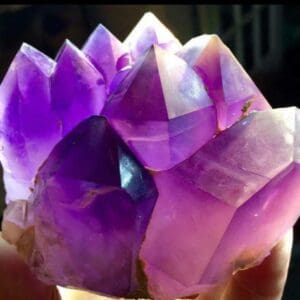
Amethyst
Amethyst is a beautiful and well-known gem which is an iron-infused variety of quartz that offers a wide range of purple hues and colorations. You’ll find shades ranging from light lavender to deep purple-colored gemstones from the tundra in Siberia. Uruguay is also known to produce grape jelly-colored material which is highly sought after.
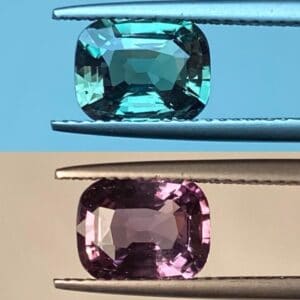
Alexandrite
Here, we have one of the most expensive precious gems around. Alexandrite changes color depending on the lighting, which is why it’s priced so high. In incandescent lighting, the stones will display a deep purple color, but when sunlight shines directly on these stones, the colors transform from purple hues to teal colors.
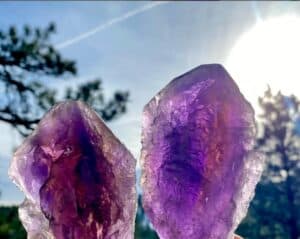
Ametrine
Ametrine is a combination of Amethyst and Citrine blended into one stone. If you’re looking to source the best material then you’ll want to buy stones that are deeply colored and have perfectly separated colors. You don’t want the purple Amethyst to bleed into the yellow Citrine. The name “Ametrine” is the combination of both stone’s names.
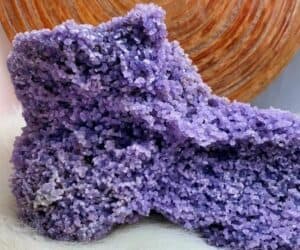
Grape Agate
This gemstone displays one of the most prominent botryoidal formations found in nature. Grape Agates almost always contain small globes that are interlocked into masses that resemble bunches of grapes. Grape Agate is a newer discovery, and it’s highly valuable. While most specimens are purple, green varieties can also be found.
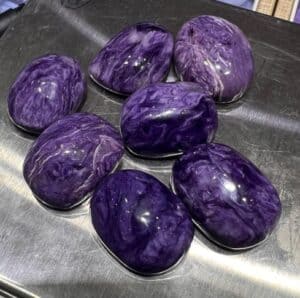
Charoite
Charoite gemstones are such deeply intense colored stones that it’s often assumed they’re dyed or enhanced. Charoite crystals offer deep purple hues with swirls, creating unique surface finishes when polished. If you look at the internal patterns closely you notice they resemble a marble-like effect. Once again, Siberia is the only known source for this material.
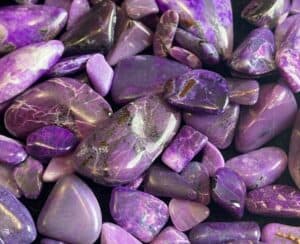
Sugilite
Sugilite is a rare silicate mineral that is only found in a few places on Earth. Their rich purple coloration combined with a mottled appearance makes them incredibly attractive. These stone’s sheer beauty and rarity mean that there’s a serious market with high prices.
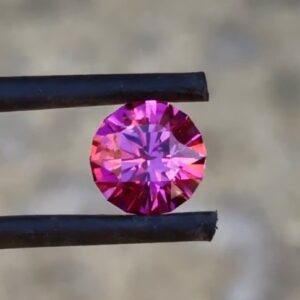
Rhodolite Garnet
People love Garnets. Garnets can be found in red, orange, and purple, but Rhodolite varieties seem to stand out among the rest. They offer a deep purple-red color that captures the attention of collectors and rockhounds. The gemstone’s colors shift slightly from burgundy to deep purple in the light.
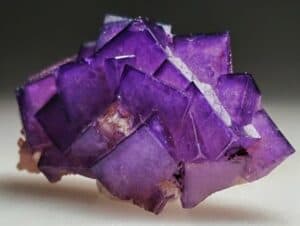
Purple Fluorite
Fluorite actually comes in various colors; Rainbow Fluorite is one of the most popular varieties in the rock trade. Purple Fluorite produces deep purple and light green hues, with the colors often being in separate bands. Fluorite is a soft mineral that’s easy to carve, but it isn’t suitable for jewelry making.
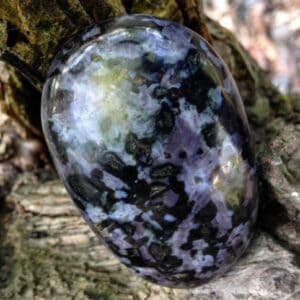
Indigo Gabbro
Indigo Gabbro is a beautiful lapidary material that’s well-suited for carving because of its attractiveness and affordability. Indigo Gabbro gems are made of grains or materials ranging from light lavender to deep purple-blue, intermixed with beautiful black grains. Nature’s end product is an incredible stone that deserves more attention.
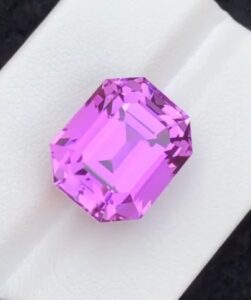
Kunzite
Kunzite gemstones are a variant of Spodumene that is found in shades of pink to light purple. While Spodumene is a relatively common mineral, it is only found in a few localities as transparent gems. While Hiddenite is the rarest Spodumene found, Kunzite is the most common.
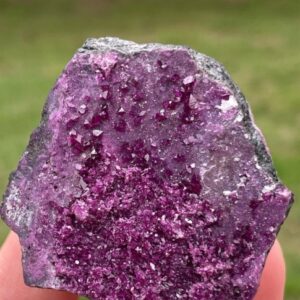
Kammererite
This incredibly soft mineral is found in Italy. Its densely packed crystal formations resemble high-grade Amethyst, but this superficial similarity is all the two stones have in common.
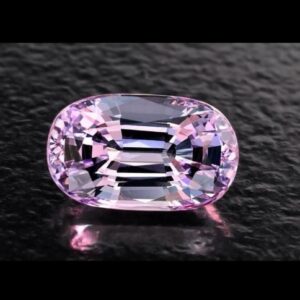
Taaffeite
Taffeite is the only one to be identified as a cut gemstone. Richard Taafe identified these crystals, and when he did, he found they had a few discrepancies with the Spinel that was being sold. After some additional testing, he determined the material was not Spinel and in fact, he had discovered a new gemstone.
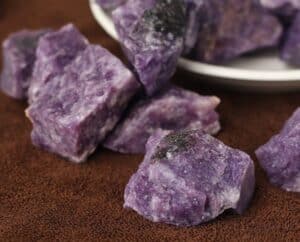
Lepidolite
Lepidolite crystals are primarily known as being an ore for the rare Earth metals Lithium and Rubidium. However, they form as lilac-to-light purple specimens. While Lepidolites are slightly lesser-known and less regarded in comparison to other dramatic varieties, tumbled and cabbed, Lepidolite gems are incredibly attractive.
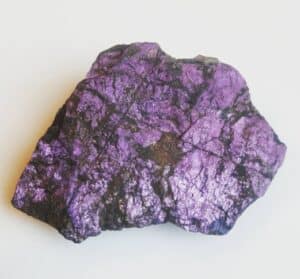
Purpurite
This manganese iron phosphate produces a deep purple coloration. Some of the best specimens are found in Namibia, where the high-grade Purpurite is readily available for export into the US markets.
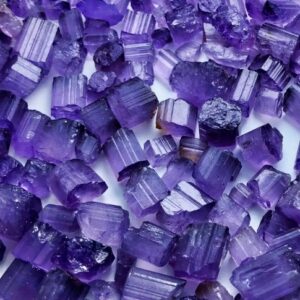
Purple Scapolite
Not very well known and is often confused with Amethyst but if you’ve seen the rough crystals and faceted stones then you’ll quickly learn how to identify purple Scapolite. The biggest visual characteristic that will lead you to properly identify purple Scapolite is the color. The purple you see will be watery and have a grey undertone. Once you see it next to a genuine piece of Amethyst you’ll never be able to unsee it.
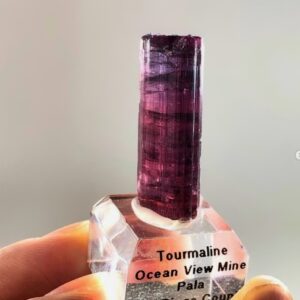
Purple Tourmaline
Purple Tourmaline is pretty rare and hard to find because the color is not commercially available. You can find every color of the rainbow in Tourmaline but purple is fairly allusive. I’ve seen a couple faceted stones and cabochons are available but they’re heavily included. The most common version will be in specimen form, like the one above. You’ll notice the tops of the crystal have a purple color while the bodies have blue or red.
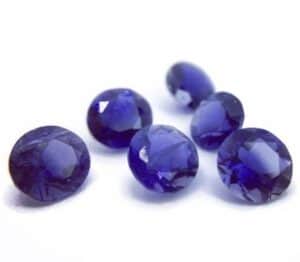
Iolite
Iolite is a lesser-known gemstone and usually has more blue than purple but I thought I would include it in the list. We looking at specimens you won’t be impressed and the actual facet rough is nothing to look at as well. It always has a greyish appearance and looks fractured but if you’re diligent you’ll come across material you can turn into cabochons and faceted gemstones.
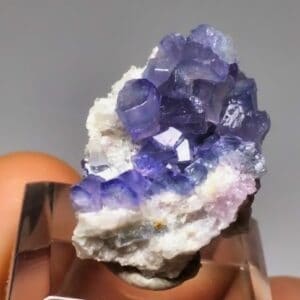
Apatite
Apatite is known for it’s blue and yellow colors but you can source purple Apatite. Most of the material is found in specimen form but you can find cabochons from time to time. You’ll notice most of the finished stones have inclusions and the purple is not deep in color.
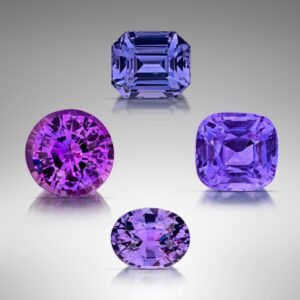
Purple Sapphire
Purple Sapphires come from a few distinct locations in the world and I’m familiar with the varieties found in Tundura. The rough is typically alluvial and on the smaller side but the colors are pretty amazing. Purple seems to be a harder color to come by but if you’re patient you’ll find material at a gem and mineral show.
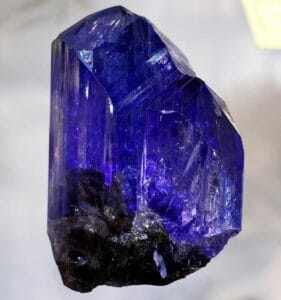
Tanzanite
Tanzanite is very popular and only found in Tanzania, hence the name. Due to its strong pleochroism, you can see stones with beep blue or deep purple and sometimes both depending on the orientation of the specimen or stone. Specimens are just as amazing as finished stones.
List of Light Purple Crystals
Since we are on the topic of purple crystals, I thought it would be a good idea to talk about different varieties based on how saturated the color is. Some crystal and gemstone collectors like the pastel colors better than the deep rich purples we have all come to know and love. So, I put together a short list of my favorite light purple crystals.
- Grape Agate – Pale whitish-purple to deep purple.
- Charoite – Lilac to deep violet.
- Rhodolite Garnet – Colors can range from light to dark purple.
- Amethyst – Lilac to purple to dark purple.
- Purple Fluorite – Ranges from light to dark shades.
- Taaffeite – Light to violet purple.
- Ametrine – Light purple to a rich violet.
- Lepidolite – Light purple to purple colors.
- Morganite – Light lavender to lilac.
- Kunzite – Shades of light violet.
- Alexandrite – Light violet.
- Mahenge Garnet – Different varieties of Garnet found in Mahenge can have a pastel purple color to them. Lapidary artist love these stones because they have a higher dispersion.
List of Dark Purple Crystals
Dark purple crystals should not be overlooked and in my opinion, the most well-known dark purple crystals have to be Siberian Amethyst. Back in the 90s, these were very difficult to source at rock and mineral shows. If you made the trek to the Tucson Gem and Mineral show then you might see a few specimens and some facet rough but you better show up early and buy it when you have the opportunity. If you waited too long, the specimens would be gone and you’d have to wait another year to source the material.
- Sugilite – Violet to deep, rich shades of purple.
- Kammererite – Violet to purple to dark purple.
- Purpurite – Reddish purple to dark purple.
- Indigo Gabbro – Indigo to purple to blackish-purple.
- Siberian Amethyst – If you’re looking for deep purple then look no further. The best of the best.
While some of the gemstones within these lists vary in hues and shades, some of the specimens fit into both the light and dark categories. I hope you enjoyed my list of purple crystals and that you find a couple of specimens or crystals to add to your collection. If you have additional questions or need help sourcing or valuing stones then feel free to reach out or join my newsletter which gives you free access to me.
- Identify Enstatite - March 12, 2024
- Identify Cerussite - March 3, 2024
- Identify Bytownite - February 18, 2024

2 Responses
Hello Mr Morris I found some Red Cap Amethyst in some rocks that were given to me and would like some more information on them if you have some that would help me make sure that is indeed what Rock Identifier says they are. Thank you and have a good day
Happy to help out. I’ll email you directly with some questions and hopefully you can send a couple of photos.